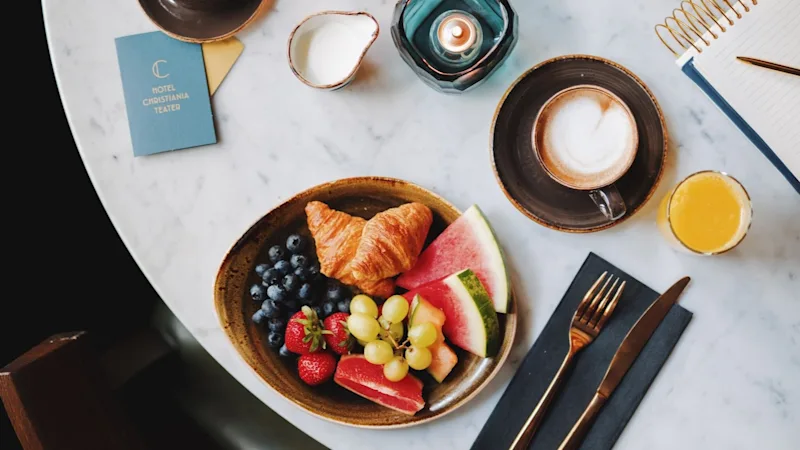Oslo's New Star Chef Jimmy Øien: Creating Fine Dining from What Others Discard
Jimmy Øien is a young new star on the Norwegian culinary scene. At his restaurant, Rest, he creates fantastic dishes from ingredients that others would throw away. "To me, wasting food is absolutely bonkers."
It's eleven in the morning. The restaurant is already buzzing with activity. A halibut is brought out, which is under the optimal weight. Unsuitable for gourmet restaurants, many would say. But not Jimmy.
Shiny red cherries are filled with out-of-date chocolate. The chef then takes out some third-grade beetroot that should never have ended up in a high-end restaurant.
Rest is Norwegian for something that's leftover. Unwanted. Like a carrot that isn't quite straight, which someone, for some reason, has decided it must be in order to be acceptable.
"I'm an advocate for logic. And I think it's completely illogical to spend an insane amount of time, effort, and resources on producing food, only to sort out what isn't 'perfect' and simply throw away a third of it all," says Jimmy Øien:
"To me, it's absolutely bonkers, actually."
At just 30 years old, Jimmy has already won gold for Norway at Bocuse d'Or as commis for Ørjan Johannesen, competed in the Culinary Olympics on the national culinary team.
And worked at prestigious restaurants like Nedre Foss Gård and Palace Grill.
He has been a stagiaire at Regis Marcon, released a cookbook, received a Green Michelin Star for sustainability, and was awarded "Young Chef of the Year" by the Michelin Nordic Guide in 2022.
Perfection Doesn't Equal the Best Flavour
We meet Oslo's new star chef at his own restaurant, aptly named Rest. The venue is centrally located in Oslo, and its philosophy is built on the very thing he's most passionate about: sustainability and reducing food waste.
The menu at Rest is therefore as uncomplicated as this:
"Our menu is a comprehensive set menu, created from the excellent ingredients our kitchen staff have been exploring lately. No à la carte. We wish to give you a treat by sharing our latest discoveries."
Jimmy tells us about growing up on a farm. Once, while holding ten freshly picked carrots in his hands, he noticed that only two of them were straight; all the others were crooked and 'odd'. Even as a child, he could see with his own eyes that food doesn't need to look perfect.
More than 20 years later, he is standing in his own restaurant, creating fine dining from vegetables that look peculiar; food that doesn't meet size or weight regulations. These standards are also unfair to farmers, Jimmy points out.
"Farmers have to follow their contracts and these rules, and when their produce doesn't fit the criteria, they can't sell it. That's absolutely mind-boggling to me. People are struggling financially, and yet we're supposed to sort out and throw away perfectly edible food?"
"Fortunately, I have a good relationship with my suppliers, so when they come across strange things, they call me right away," he says with a smile.
The lunch that sparked a passion
In Norway, we throw away over 450,000 tonnes of food annually, according to the Norwegian Institute for Sustainability Research.
The figure applies to the entire value chain, including consumers. It's difficult to comprehend this vast number, but it equates to 1.1 million kilos of edible food thrown straight into the bin, every day.
These numbers caught Jimmy's attention a few years ago when he had lunch with his collaborator Øystein Ruud in Grünerløkka. Opening their own establishment had not been on the table at the time, but they shared the same passion for food and food waste.
"We talked about how the focus on food waste was often directed at consumers, shops, and restaurants."
"But few critically examined the fact that much of what's thrown away is sorted out because it's slightly crooked, too big, or too skewed."
This conversation triggered them to take action.
"The deeper we delved into the industry, the more interesting were the raw materials we found. There's a vast sea of cool things out there, and we decided to use these leftovers to create fine dining. That's how Rest was born."
"The younger generation are born into this"
The pace at Rest is frenetic. Everyone knows what to do. It's just like in TV shows. Just ten minutes after unlocking the door, everyone's hands are washed, and everyone has buttoned up their freshly ironed white jackets. Everything happens with efficiency and set routines: one staff member on the grill, one on hot and cold, and one on pastry.
It's no coincidence that the staff around him are young. In fact, the average age at Rest is just 22 and a half.
"I want to work with young people because they're creative and challenge the established norms. They're not stuck in fixed patterns and find it easier to think differently. And of course, the people here are really talented. Despite their young age, they're already up and running," says Jimmy with a smile.
The younger generation is also more concerned with sustainability and the environment:
"I think today's generation is very conscious, whereas for many, it can be difficult to change a lifestyle they've had their entire life. I don't think it's the case that older people don't care, but it's easy to resist when the world around you is demanding change."
Jimmy's advice isn't that complicated:
"I feel that most people are good. But it's about taking care of what you have. Don't throw away food at home, use the odd ingredients, and above all, demand change in the industry."
This year's Norwegian culinary trends
Jimmy has a clear concept at his own place, but what about the food scene in Oslo in general? And what does he think of the capital as a food destination?
"I would say that modern Nordic cuisine is dominant right now. Previously, Nordic cuisine was supposed to be very simple, with few elements and often using fermentation. I feel it has now adopted more old-school techniques from France and Spain, combined with the 'weird' things that are found in the newest restaurants I've been dining at."
"Like the restaurants Einer and Savage. Much of what we do at Rest is also a mix of old techniques, combined with the new Nordic. With a twist. Does that make sense?"
Jimmy laughs.
Behind him, another employee has arrived at the station where they prepare cold dishes, sauces, and snacks. They work from Wednesday to Saturday, starting at 10 in the morning. They start by going through the week, which guests are coming, and mapping out any allergies. Then they get to work. Broth is made, it's boiled, reduced, strained, reduced again, and the big things are prepared. At 4:00 PM, the whole gang gathers for a 'family dinner'. Afterwards, the kitchen is set up for the night, and the diners start arriving. Things are then non-stop until midnight.
We continue our conversation about the capital. A lot has happened in Oslo since the pandemic, says Jimmy, stressing that there are almost more restaurants than people going out to eat.
"The advantage is that it's possible to get a table at all the places, and there are a lot of great restaurants. I would say Oslo has an interesting food scene now. We have the classic restaurants like À L'aise, and then you have more modern Nordic restaurants like Hot Shop."
The chef's favourite spots
According to Øien, Arakataka is a good place to go if you want Nordic food that isn't too expensive.
"And then there are some gems, like Szechuan Chengdu - my favourite restaurant in all of Oslo. It's an extremely good Chinese restaurant on Trondheimsveien. And let's not forget that we have one of the world's best restaurants in this city, Maaemo."
If it's time for a pint, the chef likes to head to Crowbar in Torggata.
"That's also a favourite spot. My girlfriend and I used to be there almost daily before, and it has become a regular hangout. I'm very fond of Crow."
What about coffee?
"Yes, I drink coffee. But I have it at work. That's where I spend most of my time!"
If you want to explore Oslo's culinary scene, it's a good idea to stay someplace central in the capital. The boutique hotel Amerikalinjen is located right by Oslo Central Station, the shopping street Karl Johan, and numerous restaurants - and close to the restaurants and pubs mentioned above. The hotel is also home to award-winning cocktail bar Pier 42.


